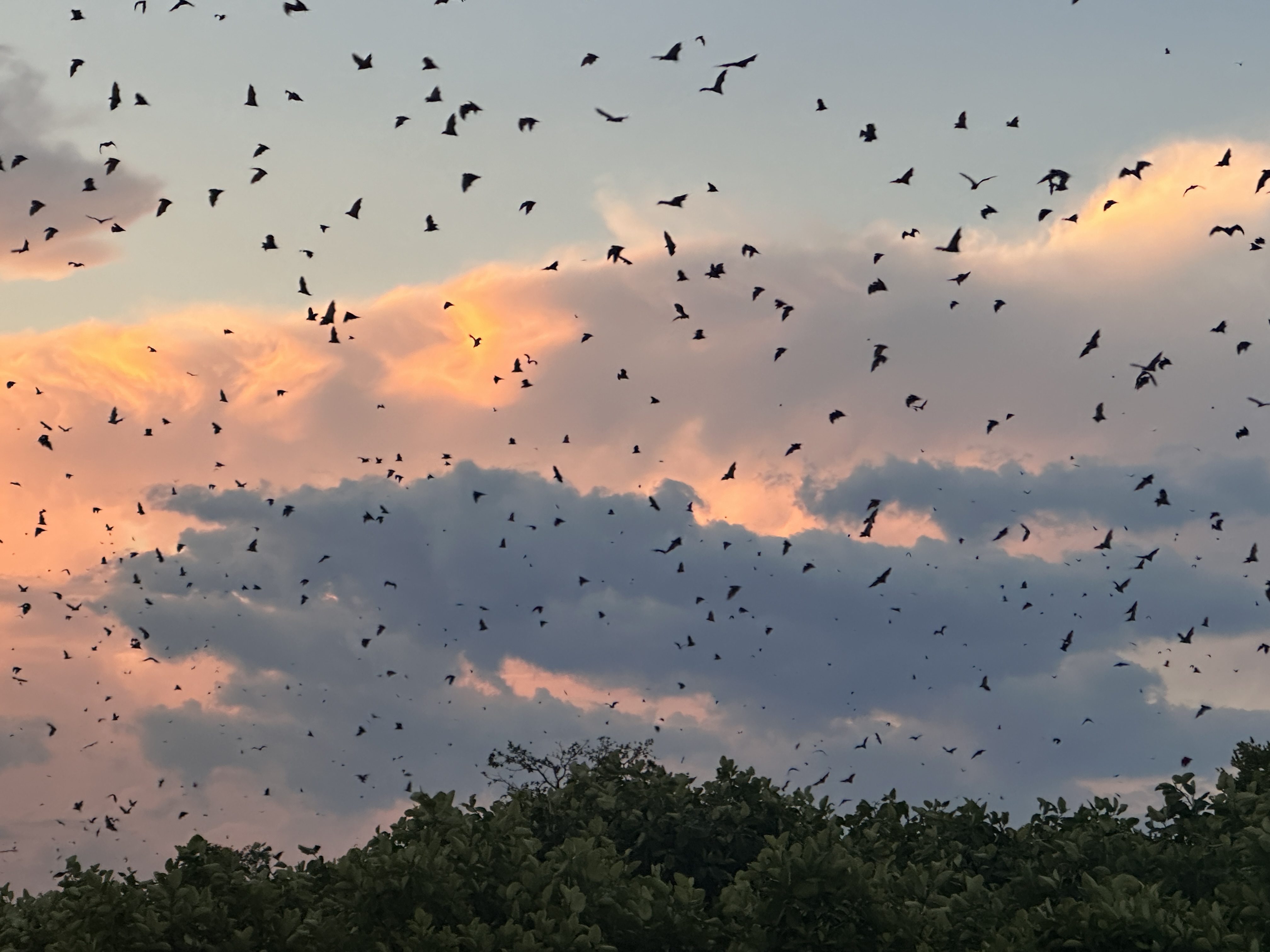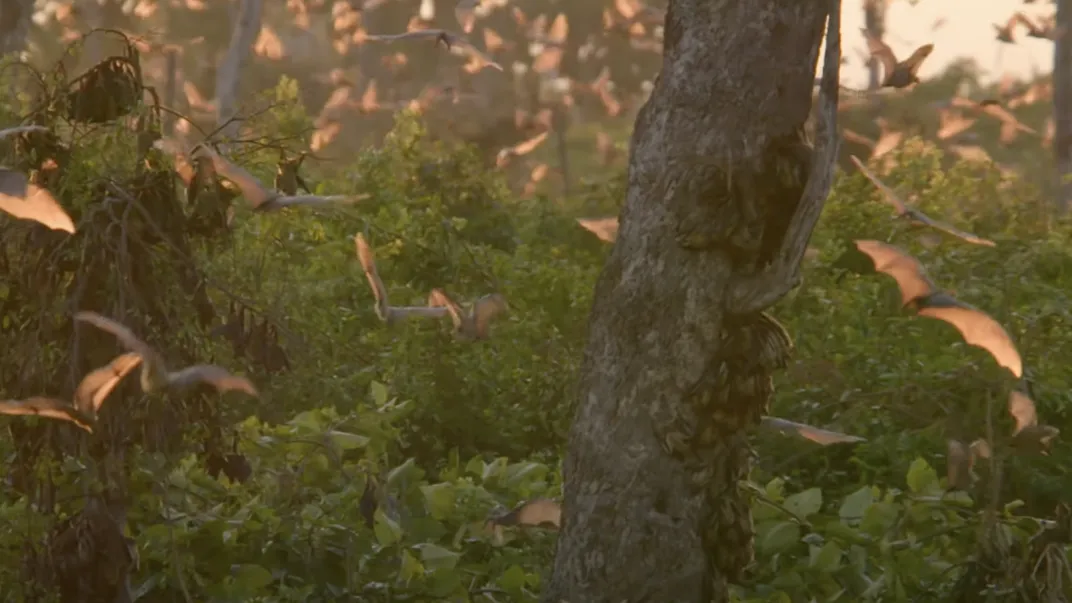Despite what hours of watching David Attenborough-voiced documentaries might lead you to believe, the world’s largest mammal migration does not involve impala, elephants and kudu making their way across the dry lands of Africa’s Serengeti. Surprisingly, it’s the congregation of millions of fruit bats over Zambia’s Kasanka National Park each year that holds the distinction.
Straw-colored fruit bats (Eidolon helvum) arrive at Kasanka, in Zambia’s Central Province, from various corners of the country and continent. They settle into the cool, swampy forest waiting for nightfall so they can arise en masse and turn the surrounding farmlands and woods into an all-you-can-eat fruit buffet. At dawn, the nocturnal mammals return to the forest to sleep off their meals, their wings casting shadows in the early light.
Witnessing the bats in flight is a mind-blowing display of nature that truly has to be seen to be believed. But getting to Kasanka is not the easiest journey—for bats or humans.
The so-called megabats, which look like flying foxes, fly in from the Democratic Republic of Congo, parts of Zambia, and sometimes Tanzania and Malawi, coming each year to fill the woods with their chirps and hang off the trees like icicles. They typically start drifting into the park around October and leave in January, though local guides say this year the first bats came on September 26, perhaps due to the country’s ongoing drought or the ripple effects of climate change.
For humans, the national park, one of the smallest of the 20 such parks in Zambia, is about an eight-hour drive from the capital, Lusaka, depending on traffic on the two-lane Great North Road. Alternatively, for the well-funded, it’s a quick hop on a private charter flight directly to Kasanka.
The sun is already rising at 4:30 a.m. on an early November day when I am picked up from Lilayi Lodge on the outskirts of Lusaka to begin the long drive to Kasanka. By noon, I arrive at the park, pay the entrance fee and wind down a dirt road past herds of deer-like puku, baboon families and the rare sitatunga antelope, into a landscape dotted with low gray termite hills that look otherworldly.
Kasanka has a few cabins and campsites, but the main place to stay in the national park is Wasa Lodge, a camp of rustic chalets on the edge of Lake Wasa. The lodge is the source of all the hot meals and electricity in the area, so long as the solar generators are working, and home base for guides who take visitors to see the bats. While the park does have hippos, elephants and one of the country’s biggest herds of sitatunga, in November, everyone is here to see the bats.
/https://tf-cmsv2-smithsonianmag-media.s3.amazonaws.com/filer_public/9b/29/9b29c4ff-d5ca-47e9-b511-7c62161c7e84/gettyimages-501882447.jpg)
About half an hour before dusk, I set out from Wasa Lodge with bat enthusiasts from France, Germany, Zambia and Japan in an open-back four-wheel-drive truck. Our destination is what Simon Siame, a wildlife safari guide at the park, calls the “bat forest.” The dark copse of swamp forest, known as mushitu, sits at the confluence of the Musola and Kasanka Rivers; it’s where the straw-colored fruit bats rest during the day. After unloading from the truck, we follow an armed guard (armed in case of angry hippos or elephants or other particularly feisty animals) through the tall grass until a bat hide, or viewing platform, appears. We climb up 60 feet onto the hide to tower over the forest and wait for the bats to wake.
Above the tree canopy, we wait expectantly in the hide as the chirping of the bats gets louder and louder. While fruit bats don’t echolocate like their insect-loving cousins, they are noisy little critters that sound like rambunctious birds. A few bats begin swooping through the dusky sky as the onlookers cheer and snap photos of the mammals spreading their leathery wings against the picturesque sunset.
When I comment on how impressive it all seems, Siame smiles and says, “Just wait.” A German couple who have come to see the migration three times nod in agreement.
A few minutes later, what looks like a shadow detaches from the forest and floats up to fill the darkening sky. It’s a cloud of wings—the wingspan of the straw-colored fruit bat is an impressive 30 inches—and furry little bodies. So many bats fly out of the forest that a panoramic camera shot barely captures the flurry. In fact, my camera has a meltdown trying to figure out where to focus, because the bats are absolutely everywhere. It’s one of those moments where laughter and tears and sheer awe are all reasonable responses. I witness the incredible display for about an hour, but mere minutes of it makes the long journey to Zambia and Kasanka entirely worth it.

The following morning at 4 a.m. we set out for the bat forest again, this time to watch the return. We shiver in a different hide, waiting in the murky pre-dawn light and listening to the sound of wings slip through the night. As the sun begins to crest, the sliver of light offers a glimpse of a battalion of bats coming in for landing. According to Siame, the bats can travel as far as 60 miles a night looking for their favorite fruits to snack on. When their food comas set in, they return to the forest, savoring the cool temperature of the shady swamp forest as they settle in to sleep, relatively safe from the crocodiles, African fish eagles and crowned eagles that can prey on them.
The straw-colored fruit bat is the only long-distance migrating fruit bat on the continent, and it’s believed that bats from several different colonies meet at Kasanka. As for why the bats come to Kasanka specifically every year, it’s a bit of a mystery. Scientists know that these straw-colored fruit bats aren’t congregating in Kasanka to breed, as they likely breed in Mozambique and Tanzania.
“In terms of understanding the reasons for migration—the tendencies for migration for bats—we don’t have a whole lot of background in it, but we believe they come for the food,” says Teague O’Mara, an expert on bat movement and behavior and the director of conservation evidence at Bat Conservation International.
It’s very relatable. Who among us hasn’t traveled in the hopes of a good meal?
“There’s a loquat that you’ll see people selling on the side of the road on the drive up to Kasanka,” O’Mara explains. “The bats really love them, too, as well as a beautiful little purple berry called a waterberry.” The bats also like the figs that grow in the swamps as well as cultivated fruits grown by farmers, including mango and bananas.
But if they’re here for the buffet, O’Mara isn’t sure why the bats come to Kasanka specifically from October to January, because the fruit is ripe and available for eating at other times of the year, too.

Straw-colored fruit bats play a vital role in the ecosystem. “They’re the best seed dispersers,” says O’Mara. “They really are Africa’s gardeners.” Since the bats love fruit, they eat as much as they can, digest the seeds and then leave them in their wake as they fly. “They’re depositing seeds in places that no other seed disperser will go. They have the potential to restore a lot of economically important timber species,” he adds. And yet several factors are contributing to a decline in their population, which numbers somewhere in the millions. Their habitat is being threatened by deforestation, with humans cutting down their roosts for farms and houses. Zambia reportedly has one of the highest rates of deforestation around the globe, which harms the bat population. People have also been known to eat the bats. They are currently listed as a near threatened species by the International Union for Conservation of Nature.
The loss of straw-colored fruit bats would have both ecological and financial implications. That’s because a colony of 100,000 or so bats can have a real-world financial impact. That one colony “can put about $800,000 worth of economic value into the economy every year,” says O’Mara. “And that’s just by doing what they naturally do.”
While scientists have a handle on the bats’ economic impact and general migration patterns, those are some of the only facts they have when it comes to this species.
Songbirds migrate in specific patterns based on genetics, but it’s unclear if Eidolon helvum pass on the vacation itinerary to successive generations. “We don’t even know if it’s the same bats coming back to Kasanka over and over again,” O’Mara says. “We don’t have a way of knowing, when we see a particular bat, if it’s going to come back again or if it has been there before.”
One of the reasons that scientists haven’t been able to track the migratory patterns of the bats closely is due to a basic tech problem. “We don’t have GPS tags or other tags that can last an entire year,” O’Mara says.
Another mystery is why the bats don’t live in Kasanka year-round. “We see, particularly in places where there’s less seasonality across Equatorial Africa and Accra [Ghana], that there are populations that have big influxes of migratory animals, but they’ll have a stable population throughout the rest of the year,” says O’Mara. “That doesn’t happen in Kasanka. Once January hits, all the bats are gone.”
Scientists, however, are slightly more confident about where bats go when they leave the national park. “We’ve seen them going into Congo. We’ve seen them going out into Malawi and start heading north into Tanzania. And then we’ve tracked one that has gone through Congo and up into South Sudan,” says O’Mara. On their travels, the bats are mostly looking for fruit and for each other. “They’re highly colonial,” he says. “They love to be around each other. They always tend to roost in really big aggregations, at least as far as the ones that we can find.”
The megabats also generally love to roost in super tall trees, except when they don’t. “Kasanka is a little bit strange for them, because the trees are really short,” says O’Mara. The bats also congregate in cities and villages, but the awe-inspiring sight of their migration is dimmed by city lights, crowded cityscapes and the bustle of urban life.
A group of animal behavior specialists recently developed a system to count Kasanka’s bats during their migration. As they explained in a September 2023 article in the Conversation, the team used both an artificial intelligence program they developed and trigonometry to count the bats. They determined that around a million bats were roosting in Kasanka at peak season in November 2019. O’Mara and the guides at the park think that number is far too low. “Just use your eyes,” says Siame, who watches the bats twice a day nearly every day when they are in the park. “That is way more than a million bats.” The guides believe the true number of bats is on the higher end of what even O’Mara cited, which was a number between 10 million and 12 million bats.
As an observer, whether it’s 1 million or 12 million, the number of bats rising out of the forest at one time is jaw-dropping. “Seeing the migratory emergence of those bats when they fly out every night at Kasanka is one of the greatest biological things I’ve ever seen,” says O’Mara.
It’s so jaw-dropping that O’Mara feels compelled to share a pro tip. “When you’re watching the bats, keep your mouth closed,” he says. “They do poop in flight.”
When some droppings catch Siame during one of our dusk bat watches, he laughs. “Well, they say it’s good luck,” the guide says.
Planning Your Next Trip?
Explore great travel deals
Smithsonian magazine participates in affiliate link advertising programs. If you purchase an item through these links, we receive a commission.
:focal(1060x706:1061x707)/https://tf-cmsv2-smithsonianmag-media.s3.amazonaws.com/filer_public/40/21/4021de0a-2fc4-4d83-9db3-7ccf2d0c3c84/gettyimages-501882427.jpg)

